Q&A – Ask Neil: November 17, 2022
(Please read these instructions carefully.)
Before you post your question, please look at recent issues to see if someone else has already asked it. You might find your answer there.
How to submit your question…
• Click here to post your question. After you submit your question, a new window will pop up giving you the address to which you can e-mail a photo to accompany your question. Clear, medium-resolution photos. (Try to avoid low-res thumbnail photos, please, in case I have to zoom in to see things.)
• Please only post your question one time.
• One question per reader, please.
• Please use this only for posting questions – not for standard emails.
• Watch for your answer in the following week’s e-gardens.
• I choose those of greatest general interest. For example, plant IDs seldom make the cut.
• I must have your first name or initials.
• I must have your city or county. (Texas is a very large state.)
QUESTION 1
WHY ARE BRANCHES OF HOLLY DYING?
Question: What is causing branches of my holly tree to die? I cannot find any insects on them. William M., Terrell.
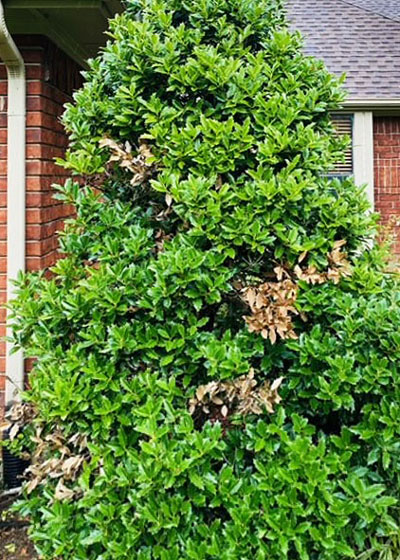
Answer: Perhaps 80 percent of my own landscape is made up of hollies, so I’ve seen this happen for several reasons. It can be due to marginal drought damage where the plant was on the verge of suffering major damage or death, but then water got to its roots in the nick of time. It also can be due to insect damage on the twigs, most commonly from bagworms tying their bags around the young twigs and girdling them in the process. Birds and squirrels sometimes will gnaw on the twigs. The cause will not be evident in the leaves, but instead along the stems. That’s if it’s visible at all. When this happens to my plants, I trim out the dead shoots and take the best possible care of the plant from that point on. Usually, the new growth fills in the following spring.
QUESTION 2
WHY ARE ALL LEAVES AT THE ENDS OF MY PECAN’S BRANCHES AND NOT IN THE MIDDLES?
Question: Our pecan tree has limbs that only have leaves at the ends of the branches. They came out that way in the spring and they have not filled in all summer. What would have caused that?
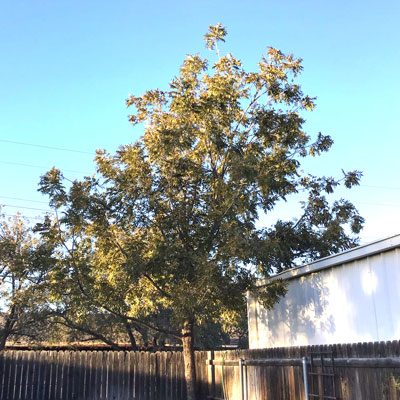
Answer: That’s not all that abnormal. I didn’t pay any attention to it when I opened up your photo. Young Chinese pistachio trees do the same thing. Within a couple of years, they fill in and grow normally. It could be a small after-effect of the cold from two winters ago, but no big issue. Keep a close eye on the branches that are rubbing your roof. They will drop down as they mature. Keep them pruned in a way that they never come into contact with the roof or the siding.
QUESTION 3
WHY ARE POST OAK’S LEAVES BROWN ON ONE SIDE OF THE TREE?
Question: My beautiful post oak’s leaves started turning brown on one side of the tree this summer. The rest of the tree looks fine. It’s very old and 9 ft. in circumference. Is this the start of its dying? Cathy A., Tarrant Co.
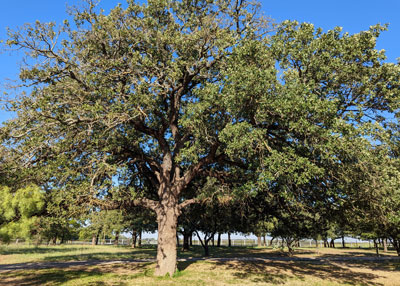
Answer: I can’t tell. In fact, I can’t see the browning. Since it happened so far back in the growing season it could be some indication of an issue. Post oaks’ normal life expectancy is 75 to 100 years. That’s comparatively short as oaks go. And they do die almost without warning. There isn’t much that can be done at this time of year unless you can see some obvious problem with the trunk or root system (which I cannot see). Keep an eye on it in early spring. If it leafs out normally it might have been nothing more than a bad reaction to the drought. If there is still a problem, you might want to have a certified arborist look at it at that point. Be careful, however, to use a firm that will be honest with you. Old post oaks are hard to save if they’re going downhill. Don’t spend large amounts of money without getting a second opinion.
QUESTION 4
DO YOU STILL RANK EASTERN REDCEDAR AND ARIZONA CYPRESS “1” AND “2” AS EVERGREENS?
Question: In a previous weekly update you discussed a disease concern developing in eastern redcedars. I have seen many dying. In your books you rank eastern redcedar a “1” and Arizona cypress a “2.” Currently, do they retain those favorable rankings?
Answer: I do not recall mentioning any “developing disease concern” related to eastern redcedars. Perhaps you are remembering my discussions of Seiridium canker that has ruined Leyland cypress as a landscape tree. That attack began 20 years ago and has become epidemic to a point that no one should count on that tree any longer. In the past 10 years the disease has moved onto Italian cypresses and more recently onto Arizona cypresses. It’s that last one that really bothers me, because before that, Arizona cypress was a lovely alternative.
Please be careful in your use of the term “ranking.” I don’t think you’re quoting me accurately. If you’re referring to how I listed those trees in my latest book Lone Star Gardening, those are ratings, not rankings. You’ll notice in all of the similar listings that there are multiple plants given ratings of “1” and “2.”
Finally, in direct answer to your question, I do believe that eastern redcedar (Juniperus virginiana) is the best “Christmas-tree-shaped” conifer for large parts of Texas.
QUESTION 5
IS THERE A YEAR-ROUND APPROACH TO CONTROLLING THRIPS?
Question: I moved from Austin to Ingram 14 years ago and have been fighting thrips ever since. Is there a systemic year-round approach to eliminating them, perhaps starting now? I only get blooms in April, and then only after the buds have been ruined. Betsy F., Kerr County.
Answer: Golly. It sounds like they were starving as they waited for you to arrive. Yes, there are systemic insecticides you can apply beginning with the new growth of late February and early March. However, I am very concerned that you might be facing rose rosette virus. Like thrips, it also causes buds to fail to open properly. The plants are stunted and usually die after two or three years. In the meantime, you will frequently see one or two extremely vigorous “bull” canes and other canes with multitudes of thorns. I have a dozen or more photos of RRV archived on my website since it has become such a common problem across much of Texas. If that’s what you’re fighting, insecticides aren’t going to help at all. Please read what I’ve written.
QUESTION 6
DOES A CERTIFIED ARBORIST NEED TO REMOVE THIS GIRDLING ROOT?
Question: Is the root around this tree small enough for us to remove, or should a professional do it? Cindy R., Waco.
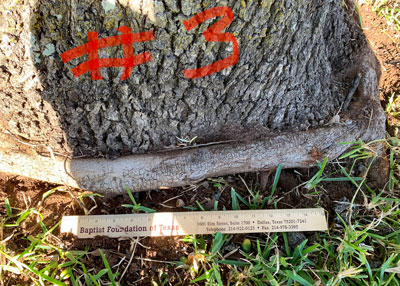
Answer: (I’ve opted only to use one of your photos since they seem to overlap pretty much.) If you are very patient and careful, you could probably do this yourself. You would want to use a very sharp chisel and carefully cut through the girdling root without hacking into the rest of the trunk. You’ll probably have to take it out in small pieces. Much would depend on how healthy the top growth of the tree has been in the past several years. If it’s strong and vigorous you should be fine, but if it has dragged the tree down, there may be other work that will be needed. A certified arborist would recognize what, if anything, should be done.
QUESTION 7
IS THIS A FUNGUS IN OUR BERMUDA?
Question: Our bermuda lawn has what we identified as a fungus. Our local nursery suggested spraying with a fungicide. We did so three weeks ago, but we haven’t seen any improvement. Do you have any advice? Mitzi H., Fort Worth, but in Parker County.
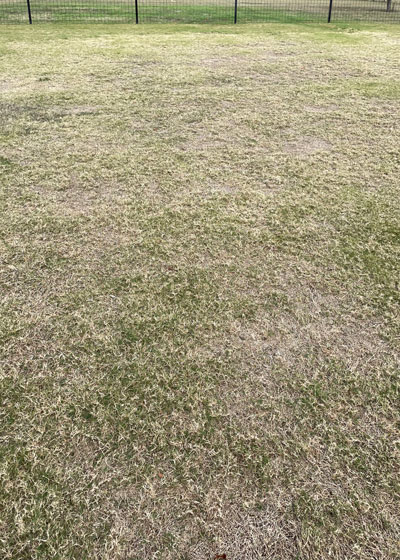
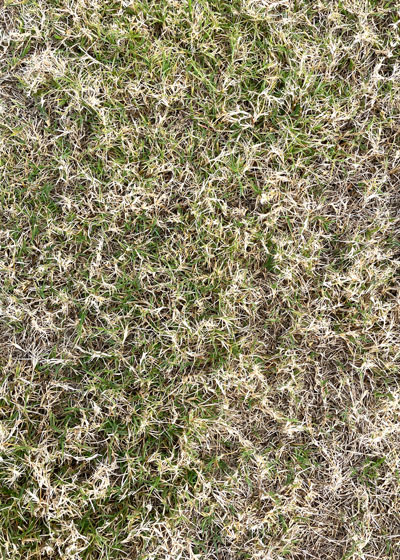
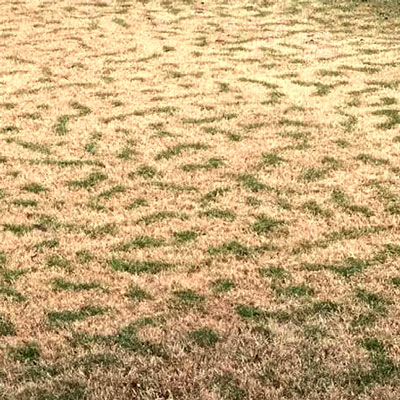
Answer: I don’t see any evidence of a fungus in either of your photos. What I do see is green growth beneath the dead grass. So, I have a theory. (That’s when I’m most dangerous.) Parts of North Central Texas had a killing frost about the same time you were seeing a problem. Bermuda turf takes on a very strange browning pattern when it is “kissed” by frost. (See my photo.) It turns brown in a very regular, wavy design. If that’s what you were seeing, the cold was the culprit (no problem at all). The grass was greening up last week when you submitted your photos. By now you’ve had another freeze or two and it’s probably turned brown again. But, back to your question, I see no fungus and no need to treat.
QUESTION 8
CAN I MULCH MY RED OAK LEAVES INTO THE LAWN?
Question: You recommend mulching fallen leaves and using them as mulch in flowerbeds. Is there any problem in just mulching them into the grass? I have healthy St. Augustine, a big red oak and several crape myrtles. Paul T., Temple.
Answer: Without seeing your red oak or your St. Augustine, I’m going to give an answer that would apply in 99 percent of the lawns that I see. Mulching fallen leaves back into the lawn would be just fine for about 49 weeks out of the year. But for the 3 weeks of prime leaf drop, especially for trees with large leaves such as red oaks, it would represent too much organic matter being introduced into a small area in a very big hurry. That’s why I suggest taking that mass of leaves off the lawn and using them in the compost pile or to mulch shrub or perennial beds.
QUESTION 9
WHY ARE OAKS’ LEAVES SHOWING BROWNED TIPS?
Question: My two oak trees began having brown tips of the lower leaves in late July. The browning has since progressed toward the bases of the leaves and to leaves higher in the trees. I initially thought it was related to heat, but now I’m concerned about diseases. What are your thoughts? Kyle C., Granbury.
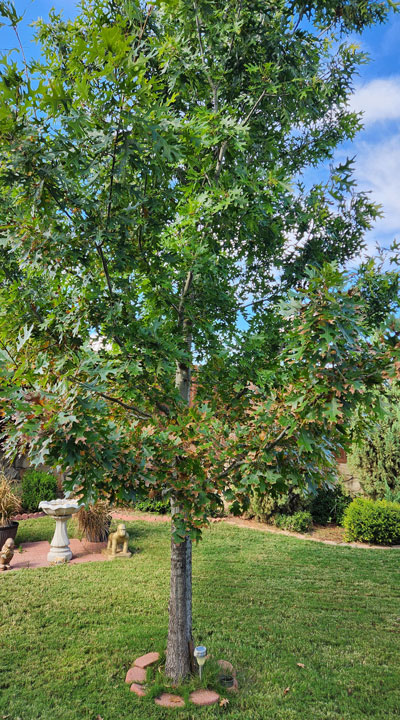
Answer: It’s unusual for lower, older leaves to be showing the browning like this. That usually points to a problem from some time in the early part of the growing season that has, by now, been resolved. Or it might suggest that the lower leaves are being sprayed with irrigation water with a high sodium content. When I zoom in on the bottom of the trunk of the one tree you photographed it looks like there is an area of decay at the ground line. That might also somehow be involved. Keep an eye on it, but otherwise, let’s see what develops over the winter. Hopefully the trees will look more normal as they leaf out in the spring.
QUESTION 10
HOW DO I REMOVE THIS FROM THE BASE OF MY RED OAK TRUNK?
Question: How do I get rid of this growing on the trunk of a Texas red oak? I remove it, but it keeps coming back. Cacy M., Colleyville.

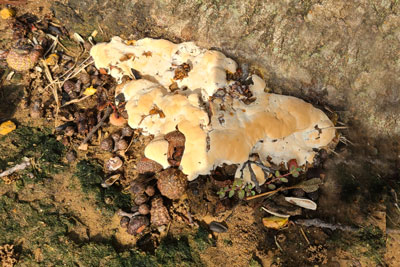
Answer: This is a fungal conk – one of the many forms you will see growing on the bases, trunks and branches of trees. They are interesting, but they are often indicators of internal decay far beyond what you might expect. You need to have a certified arborist check this tree out carefully. This is not the answer you are hoping to hear, but I fear that it may need to be removed before it falls in a wind or ice storm. I rarely do this (refer directly to one of my e-gardens advertisers or radio sponsors in one of my answers), but our advertiser here in e-gardens, Arborilogical Services has taught me much of what I know about fungal conks. They do serve your area and could give you excellent help if anyone can. Here is what the Georgia Forestry Commission has to say about conks.
Here is what Arborilogical Services has about conks on their own website.
QUESTION 11
IS LACK OF WATER THE REASON THESE HOLLIES HAVE STRUGGLED?
Question: These hollies have struggled for a few years. They are somewhat under a live oak, but they get lots of morning sun. Is this a water issue? We have clay soil in this part of our yard. Cameron N., Fort Worth.
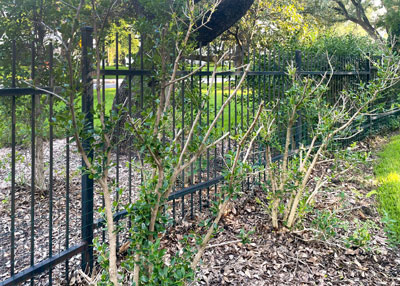
Answer: It certainly looks like moisture issues to me. It’s not insect- or disease-related because hollies don’t have those. It’s not due to the shade because the plants aren’t leaning out “toward the sun.” It wasn’t caused by the cold of February 2021 because hollies came through with flying colors, also because the rest of your hollies are all intact. About all that’s left is moisture stress brought on by the competition for water between the hollies and the live oak. Much of that issue may have built up in summer 2022.
QUESTION 12
WHY SO MANY POST OAK ACORNS THIS YEAR, AND HOW CAN I GROW SEEDLINGS FROM THEM?
Question: Post oaks here have a plethora of acorns this year. What are the factors that determine acorn production, and how can I grow seedlings from these? Jack K., College Station.
Answer: Oaks, like pecans and other nut-producing trees, will vary in numbers of acorns produced from one year to the next. You’ll have a large number one year, then none, then an intermediate, and so on and on. Weather has a decided impact, especially drought and to a lesser extent heat and cold.
As far as getting acorns to germinate, plant them as soon as possible after they hit the ground. There are larvae that feed on the acorns’ embryos. Any acorns that rattle or that float should be discarded, as should any that have holes in the sides of the acorns. Plant the good acorns in quart or gallon pots filled with loose potting soil. They should be pushed in two or three times as deep as they are tall. Water them thoroughly. Make some provision to keep digging-type animals out of the pots. Hopefully you can get a fairly high percentage of germination, although post oaks are cantankerous trees that really don’t like humans. That’s why you will never see them grown or sold in nurseries. In fact, I might suggest you consider growing bur oaks instead. They look like post oaks (except for the acorn size!), yet they’re better, longer-lasting trees.
